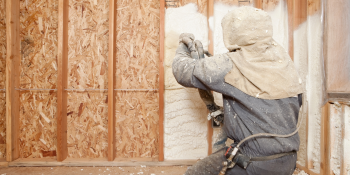Q&A Forums
OC foam in attic, did I miss Something How is this guy getting away with this? Post New Topic | Post Reply
| Author | Comments |
|---|---|
|
Posted: Aug 03, 2010 11:35 AM
|
OC foam in attic, did I miss Something How is this guy getting away with this?
So I'm here in Indiana, I am fairly new to the game compared to you guys, but I have been a builder for many years, I spent almost a year researching and going to 3 different foam "schools" (and countless hours on here) before I pulled the trigger on some nice hydraulic equipment, I use 2 lb CC foam With the ICC rating, I have been sold on the CC product for a while now. Well this week I am at a local event promoting my product and company. In comes an Newer than me Spray foam guy he is shooting and promoting the use of Open Cell foam in the attics UNCOVERED no coating, also he is quoting and promoting this oc foam in the attic at 6" depth or just covering a 2X6 is perfectly fine and a great product. How the Hell is this Code Compliant? His literature states a 3.5" fill at a R-13, So given the benefit of a doubt and say it all gets a 7" average fill to cover the 2X6 that's still a R26. I was under the impression All attic insulation had to be at least a code minim of R-38. he swears he has had inspections and never had a issue passing??? Plus it is UNCOVERED no coating, Again I was under the understanding All open cell foam had to be covered in a attic. Thanks for all input
|
|
mason
Posted: Aug 03, 2010 02:42 PM
|
Folks frequently can get code officials to approve items that do not specifically meet the code. I would contact the code official in your area and try to educate him or her in the specific portions of the code that pertain to SPF applications. Then it is up to your competitor to demonstrate that he is complying with the code using an approved alternate method that is at an equal or better based on diversified testing (such as would be identified on a currently dated ICC Evaluation Report) |
|
Posted: Aug 04, 2010 08:54 AM
|
Thanks for the response, Can you point me in the direction of the official print version that you refer to as far as using SPF in attics specifically the OC products? Here is a related question I have kinda always had in the back of my mind. I'm not opposed to using open cell foam in a attic, but the cost and time of the proper coating is what steered me away from using it in this application. But lets say for arguments sake there is no air handler or furnace in the attic. And lets also say the attic access is secured with screws and sealed with caulk (This is a practice that a large production builder in this area uses for warranty purposes). Why does the drywall not count as a approved barrier? Is there something specific in the code that says it must be fastened within a certain amount of inches? Since there is no air handler or furnace in the attic that would require routine maintenance or service personnel entering the attic under normal circumstances it seems it would be considered "closed up" similar to a wall structure. Just wondering |
|
mason
Posted: Aug 04, 2010 11:35 AM
|
Unvented Attic The 2007 ICC supplement, IECC section 202 definitions, introduced 3 new classes of vapor retarders as follows: • Class 1: 0.1 perms or less • Class II: 0.1 to 1 perm • Class III: 1.0 perm to 10 perms Medium density SPF at 2-3 inch thickness typically falls into the Class II category while low density SPF at 3.5-5.5 inch thickness typically falls into the Class III category. International Residential Code (IRC) section R 806.4: Unvented attic assemblies. “Unvented attic assemblies (spaces between the ceiling joists of the top story and the roof rafters) shall be permitted if all the following conditions are met. • The unvented attic space is completely contained within the building thermal envelope. • No interior vapor retarders are installed on the ceiling side (attic floor) of the unvented attic assembly • Where wood shingles or shakes are used, a minimum of ¼” vented air space separates the shingles or shakes and the roofing underlayment above the structural sheathing. • In climate zones 5, 6, 7, and 8 any air-impermeable insulation shall be a vapor retarder, or shall have a vapor retarder installed in direct contact with the insulation (would apply to low density (0.5 pcf) SPF). • Either items a, b, or c shall be met, depending on the air impermeability of the insulation directly under the structural roof sheathing: a. Air impermeable insulation only. (for example, closed cell SPF) Insulation shall be applied in direct contact with the underside of the structural roof sheathing b. Air-impermeable insulation only. In addition to the air-permeable insulation installed directly below the structural sheathing, rigid board or sheet insulation shall be installed directly above the structural roof sheathing as specified in Table 8 (not included in this document) for condensation control. c. Air-impermeable and air-permeable insulation. The air-impermeable insulation shall be installed to the underside of the roof sheathing as specified in Table R806.4 (not included in this document) for condensation control. The air permeable insulation shall be installed directly to the underside of the air-impermeable insulation.” (This section would apply to flash and batt systems where a layer of closed cell SPF is installed to the underside of the roof deck and another insulation such as fiberglass is installed directly to the SPF) In the 2009 code the vapor retarder classifications were moved to the International Building Code structural section Now as to ignition barriers in attics. I asked the ICC staff and the ICC Evalaution Services for an opinion as to what constitutes a space designated only for service of utilities. Their response was that even if there was no equipment, ducts, etc in the attic or crawl space, that they would consider it a space designated for service of utilities if there was an access hatch leading into it from the interior of the structure. So, most of your attic spaces would be considered in this category based on that opinion. If there were a door leading to the attic, and/or air registers leading directly from inhabited spaces, it might be considered inhabited space and require thermal barrier instead of an ignition barrier. If the hatch is sealed and caulked, I would consider it not a space for service of utilities. But check with your local code official for his opinion. |
|
mason
Posted: Aug 04, 2010 11:47 AM
|
Thermal and ignition barrier requirements for foam plastics in residential construction is listed in the International Residential Code (IRC) section 316, Foam Plastics. Section 316.4 Thermal Barriers: Unless otherwise allowed in Section 316.5 or Section 316.6 foam plastic shall be separated from the interior of the building by an approved thermal barrier ... Section 316.5.3 Attics The thermal barrier specified in section 316.4 is not required where all of the following apply; 1. Attic access is required by Section R 807.1 (Note this section states: "Buildings with combustible ceiling or roof construction shall have an attic access opening to attic areas that exceed 30 sq ft and have a vertical clearance of 30 inches of more") 2. The space is entered only for purposes of repairs or maintenance (note they deleted for service of utilities to eliminate the confusion) 3. The foam is protected against ignition using on of the following ignition barrier materials. 1.5 inches of mineral figer 1/4 inch of wood structural panel 3/8 inch of particle board 1/4 inch of hardboard 3/8 inch of gypsum board The above ignition barrier is not required where the foam plastic insulation has been tested and approved in accordance with Section 316.6 (which lists fire tests acceptable to the codes) So to amend my earlier post, the codes in the 2009 book are more clear. You have to have an attic hatch if there is a 30 inch clearance and 30 sq ft of space. If you have a required attic hatch then you can use an ignition barrier if the space would only be entered for repair or maintenance, (note repair could mean repair of roof, electrical, plumbing elements as well as HVAC and ductwork.) |




























